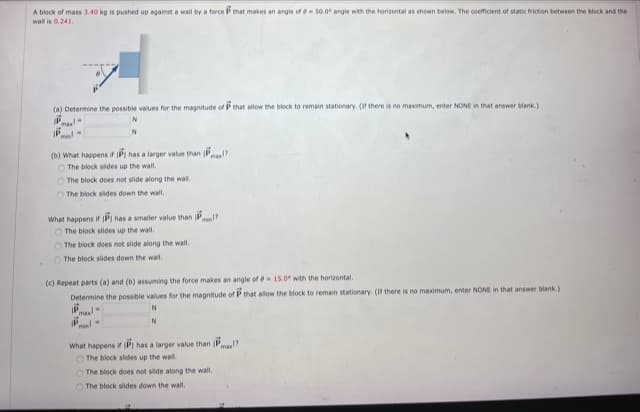A block of mass 3.40 kg is pushed up against a wall by a force Pthat makes an angle of- s0.0 angle with the horizontal as shown below. The coemicient of static triction between the block and the wall is 0.241.
A block of mass 3.40 kg is pushed up against a wall by a force Pthat makes an angle of- s0.0 angle with the horizontal as shown below. The coemicient of static triction between the block and the wall is 0.241.
Physics for Scientists and Engineers: Foundations and Connections
1st Edition
ISBN:9781133939146
Author:Katz, Debora M.
Publisher:Katz, Debora M.
Chapter5: Newton's Laws Of Motion
Section: Chapter Questions
Problem 76PQ: Jamal and Dayo are lifting a large chest, weighing 207 lb, by using the two rope handles attached to...
Related questions
Question

Transcribed Image Text:A block of mass 3.40 kg is pushed up against a wall by a force P that makes an angle of-50.0 angle with the horizontal as shown below. The coemicient of static triction between the block and the
wal is 0.241.
(a) Determine the possible values for the magnitude of P that allow the block to remain stationary. (If there is no maximum, enter NONE in that answer blank.)
Pml-
(b) What happens if IPI has a larger value than P
O The block sides up the wall,
O The block does not side along the wal.
O The block sides down the wall.
What happens if PI has a smaller value than Pl?
O The block slides up the wall.
O The block does not slide along the wall.
O The block slides down the wall.
(c) Repeat parts (a) and (b) assuming the force makes an angle of 15.0 with the horizontal.
Determine the possible values for the magnitude of P that allow the block to remain stationary. (f there is no maximum, enter NONE in that answer blank.)
ma
What happens if PI has a larger value than Pmal?
O The block slides up the wal.
O The block does not slide along the wall.
O The block slides down the wall.
Expert Solution
This question has been solved!
Explore an expertly crafted, step-by-step solution for a thorough understanding of key concepts.
Step by step
Solved in 4 steps with 4 images

Recommended textbooks for you

Physics for Scientists and Engineers: Foundations…
Physics
ISBN:
9781133939146
Author:
Katz, Debora M.
Publisher:
Cengage Learning

University Physics Volume 1
Physics
ISBN:
9781938168277
Author:
William Moebs, Samuel J. Ling, Jeff Sanny
Publisher:
OpenStax - Rice University

Physics for Scientists and Engineers: Foundations…
Physics
ISBN:
9781133939146
Author:
Katz, Debora M.
Publisher:
Cengage Learning

University Physics Volume 1
Physics
ISBN:
9781938168277
Author:
William Moebs, Samuel J. Ling, Jeff Sanny
Publisher:
OpenStax - Rice University